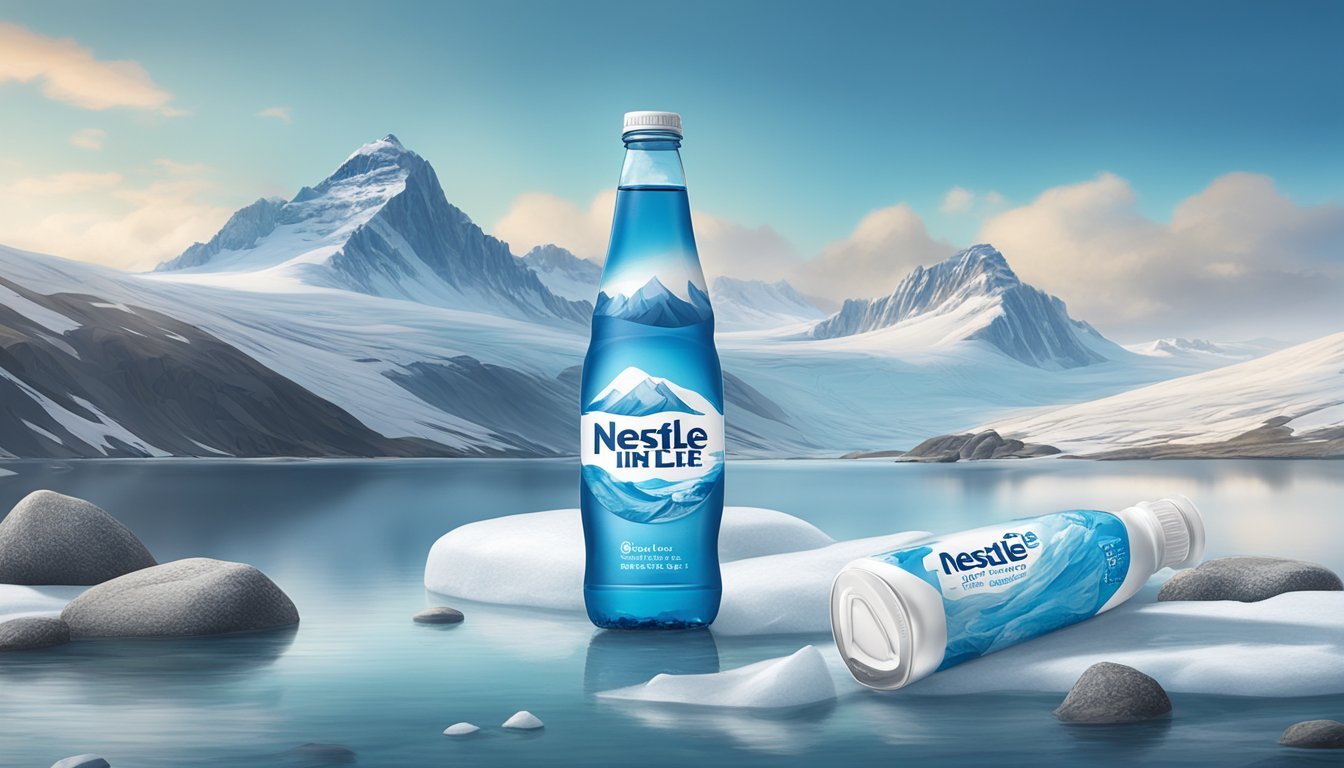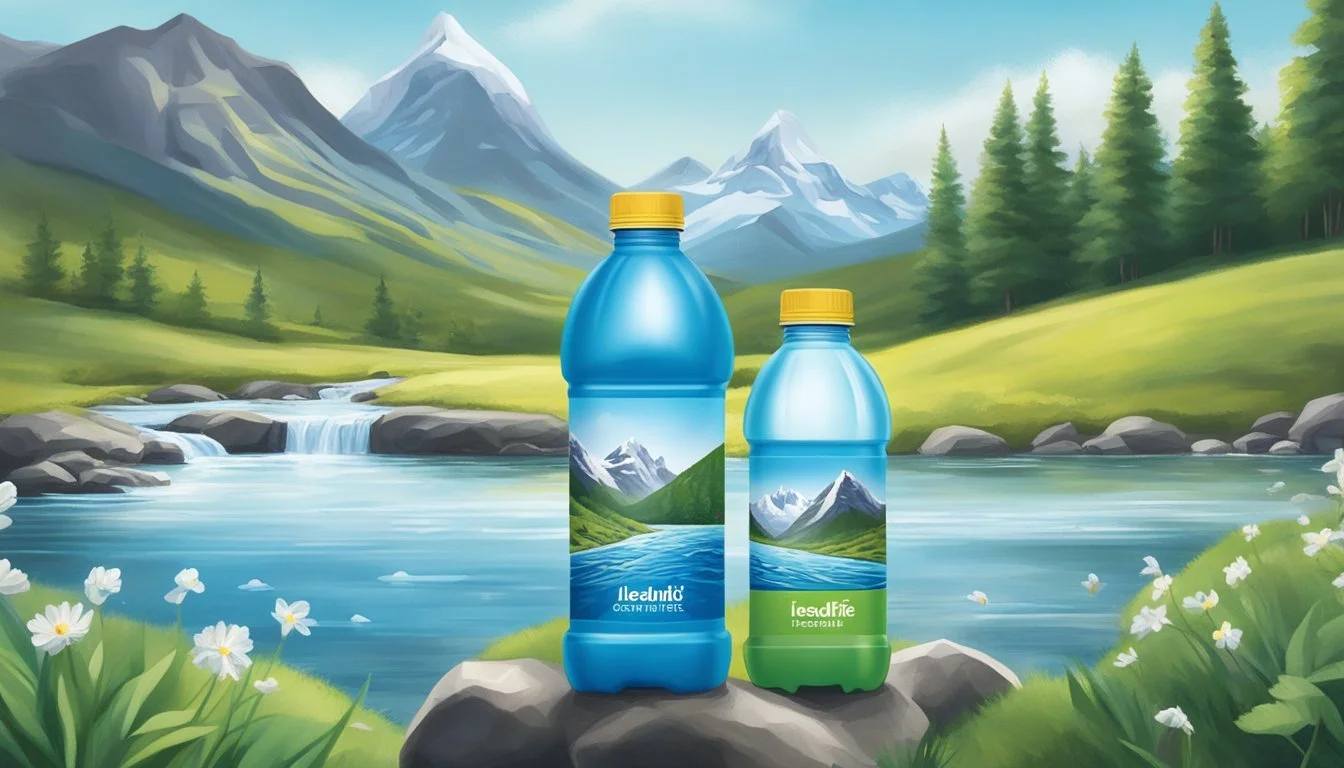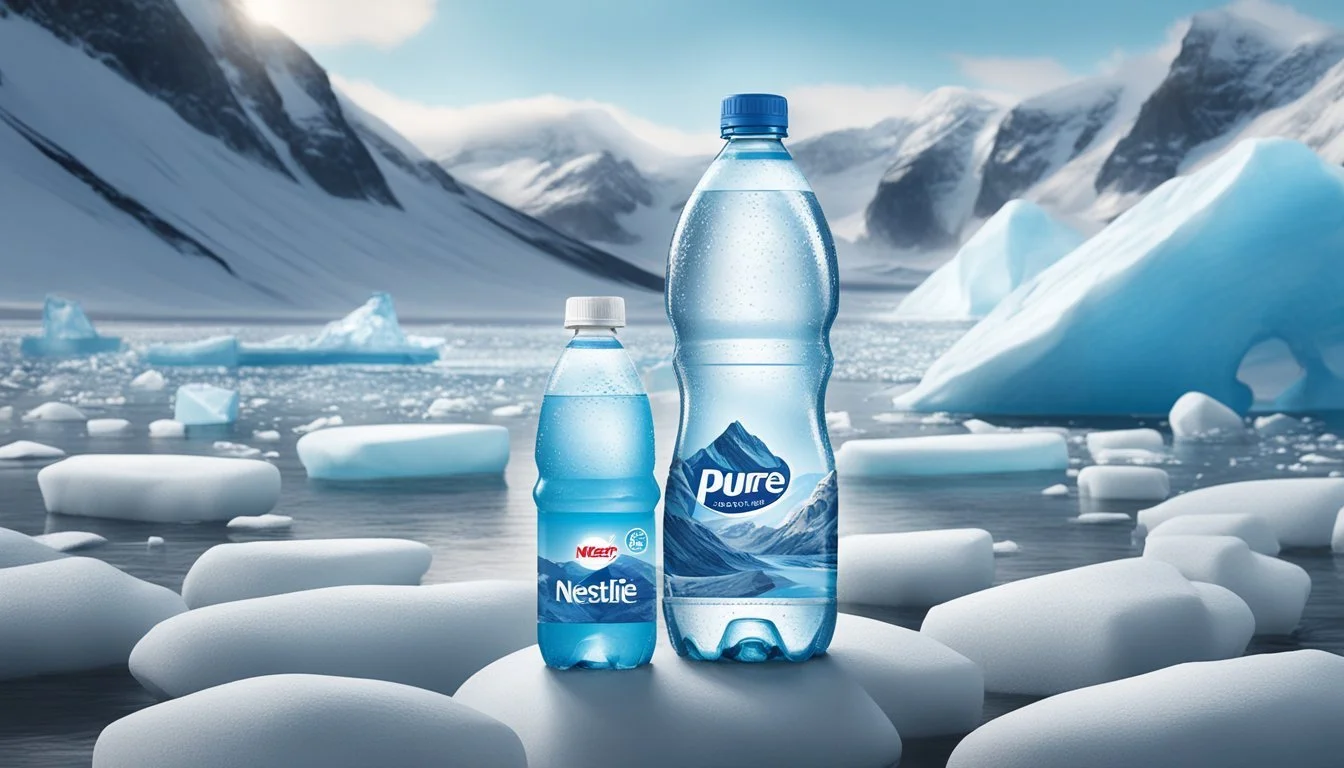Icelandic Glacial vs. Nestlé Pure Life
Comparing Quality and Taste
Selecting the right bottled water can be surprisingly nuanced, given the array of choices available to consumers. Icelandic Glacial and Nestlé Pure Life are two prominent brands that stand out in the market, both commanding attention, but for different reasons. Icelandic Glacial touts its source as the legendary Olfus Spring in Iceland, known for its natural filtration and low mineral content, providing a crisp and refreshing taste. The brand takes pride in delivering an exceptionally pure product and places a significant emphasis on environmental sustainability in its packaging and production methods.
Conversely, Nestlé Pure Life, a brand under the umbrella of the world's largest food and beverage company, Nestlé, offers a product that is easily accessible and affordable. This brand is associated with consistent taste and wide availability, which has contributed to it becoming a household name in many regions. Despite its global presence, Nestlé Pure Life is often described as a standard offering without remarkable distinction in its taste or source.
As bottled water consumption continues to grow, consumers are increasingly becoming interested in the nuances that distinguish one brand from another, ranging from the source of the water to the presence of minerals and additives. Therein lies the essence of this comparison: understanding whether the premium associated with a water like Icelandic Glacial translates into a superior experience over a more ubiquitous brand like Nestlé Pure Life.
Background on Bottled Water Industry
The bottled water industry has seen exponential growth, evolving consumer preferences and a competitive landscape defined by a multitude of brands such as Fiji, Evian, Dasani, and Aquafina. It has become a significant segment in the beverage market with notable differences in water sources and types.
The Rise of Bottled Water
Bottled water's appeal stems from its convenience, perceived purity, and the belief in health benefits over other beverages. In the past few decades, consumers have increasingly chosen bottled water, leading to a surge in demand and the emergence of numerous water brands.
Companies like Nestlé have capitalized on this trend, offering products like Nestlé Pure Life, which satisfy a growing market of health-conscious consumers. Conversely, brands like Icelandic Glacial market themselves on the purity of their spring sources and sustainable practices.
Types of Bottled Water
There are several types of bottled water available on the market, with each brand often providing a range of options:
Spring Water: Sourced from natural springs, this type includes brands like Evian and Icelandic Glacial.
Purified Water: Water from this category has undergone filtration and other purification processes. Aquafina and Dasani fall into this category.
Mineral Water: Containing natural minerals and trace elements, Fiji is a popular brand in this segment.
Distilled Water: This is water that has been boiled into vapor and condensed back into a liquid, removing minerals and contaminants.
Each type caters to different consumer needs, from those seeking taste and mineral content to those prioritizing purity.
Leading Brands Overview
The market is dominated by a few leading brands, each with its unique selling point:
Fiji: Known for its natural artesian sources and distinct taste due to silica content.
Evian: Sourced from the French Alps, Evian is marketed towards luxury consumers and is often associated with high-end dining.
Dasani and Aquafina: Both are owned by soda giants Coca-Cola and PepsiCo, respectively, known for their purified drinking water.
Icelandic Glacial: This brand touts the purity of Iceland's water and its commitment to sustainability.
Nestlé Pure Life: Produced by the world's largest food company, Nestlé, this brand is known for its affordability and wide availability.
These brands differentiate themselves through sourcing, purification processes, and marketing strategies, vying for consumer attention in a crowded marketplace.
Health and Safety Aspects
When considering Icelandic Glacial and Nestlé Pure Life bottled waters, it is crucial to evaluate their quality, mineral content, and compliance with safety standards to determine which is better for consumption from a health and safety standpoint.
Water Quality and Contaminants
Icelandic Glacial boasts a source from the Olfus Spring in Iceland, known for its low levels of contaminants. Filtration process: It undergoes natural filtration through lava rock which contributes to its purity. Testing has shown negligible amounts of heavy metals or lead, making it one of the safer choices.
Nestlé Pure Life, on the other hand, undergoes a multi-step filtration process that includes reverse osmosis and/or distillation. The brand has faced scrutiny regarding the presence of microplastics and PFAS chemicals in some of its products, although levels are reported to be within regulatory limits.
Brand Lead Heavy Metals PFAS Chemicals Icelandic Glacial Not detected Minimal Not detected Nestlé Pure Life Within safety limits Within safety limits Within safety limits
Mineral Content and Benefits
Icelandic Glacial has a naturally alkaline pH level and contains essential minerals like calcium, potassium, and magnesium, which are beneficial for health. Mineral content is not only necessary for hydration but also contributes to the taste.
Nestlé Pure Life also includes essential minerals. However, these are added back to the water after the extensive filtration process. The addition of electrolytes is aimed to enhance taste and promote hydration.
Brand Calcium Potassium Magnesium Icelandic Glacial Present Present Present Nestlé Pure Life Added Added Added
Safety Standards and Regulations
Both brands comply with international and national safety standards and regulations for bottled water, including regulations by the FDA and EPA. They both operate under strict protocols to ensure safety from BPA in packaging and maintain a standard for acceptable arsenic levels.
Icelandic Glacial's packaging is BPA-free, which is a significant consideration for consumers looking to avoid this particular contaminant. Nestlé Pure Life has also made commitments to reducing BPA in their bottles, though public awareness and concern about plastic packaging persist.
Regulatory bodies periodically review permissible limits for contaminants, and both brands have historically met or exceeded these requirements, ensuring their bottled water is safe for consumption.
Environmental Impact
The environmental impact of bottled water is a significant issue that encompasses plastic waste concerns, the sustainability of bottling practices, and the exploration of alternative packaging solutions.
Plastic Waste and Environmental Concerns
Icelandic Glacial and Nestlé Pure Life have different approaches to addressing the environmental concerns surrounding plastic waste. Nestlé Pure Life utilizes PET plastic bottles, which are BPA-free and recyclable. They are committed to making 100% of their packaging recyclable or reusable by 2025. However, the production and disposal of PET bottles can still contribute to environmental degradation if not properly managed.
Icelandic Glacial, on the other hand, has taken steps to reduce their carbon footprint and also offers their water in rPET bottles made from recycled plastic. The company’s efforts to lessen plastic waste align with their broader environmental goals.
Sustainable Practices in Bottling
When it comes to sustainable practices in bottling, Icelandic Glacial stands out with its use of Iceland’s renewable energy resources in its bottling processes. They claim to be the world’s first certified carbon-neutral bottled water brand, reflecting their commitment to sustainability.
Nestlé Pure Life also implements several measures aimed at sustainability. They have initiated projects that focus on water stewardship and reducing the amount of plastic in their bottles.
Alternatives to Plastic Bottles
Both brands have explored alternatives to plastic bottles to reduce waste. Icelandic Glacial offers water in glass bottles, which can provide a more sustainable alternative due to their reusability and the reduced environmental impact when recycled.
On the other side, Nestlé Pure Life encourages recycling and has researched alternative packaging solutions, although they are primarily known for their plastic bottled water products. The industry as a whole is exploring different materials and designs to minimize the environmental footprint of bottled water.
In the context of environmental impact, both brands have recognized the importance of sustainable practices and reducing plastic waste, with Icelandic Glacial often being lauded for their eco-friendly initiatives.
Sourcing and Production
In assessing Icelandic Glacial and Nestlé Pure Life bottled waters, their sources and production methods offer a stark contrast in origins and procedures.
Water Source and Extraction
Icelandic Glacial derives its water from the Olfus Spring in Iceland, a renewable resource fed by rain, snowmelt, and glaciers. The extraction process is sustainable, ensuring that the spring is not depleted, and involves minimum intervention.
In contrast, Nestlé Pure Life sources its water from various global sources, including some deep wells and municipal supplies. Nestlé often labels its product as purified water, which means it originates from groundwater or public water sources and is then purified.
Filtration and Bottling Processes
The filtration process for Icelandic Glacial involves natural lava rock, which is said to enhance the mineral balance without human intervention. Their production emphasizes eco-friendly practices throughout the bottling process, utilizing geothermal and hydroelectric power to reduce environmental impact.
Nestlé Pure Life, on the other hand, undergoes a rigorous, multi-step purification process. This includes demineralization and reverse osmosis, with the addition of a blend of minerals for taste before the water is bottled. Nestlé's operations focus on efficiency and convenience, offering widespread availability and affordability.
Comparison of Icelandic Glacial and Nestlé Pure Life
In this section, the focus is on directly contrasting Icelandic Glacial and Nestlé Pure Life across various key factors, from their sources and production methods to environmental impact and consumer accessibility.
Source and Production Differences
Icelandic Glacial water originates from the Ölfus Spring in Iceland, known for its high-quality and naturally filtered spring water. The company boasts that the source has a high rate of replenishment, which speaks to its sustainable harvesting. Nestlé Pure Life, on the other hand, sources its water from various wells or municipal supplies, after which the water goes through an extensive purification process.
Taste Profiles and Water Quality
Icelandic Glacial:
Taste: Reportedly rich and refreshing, with a balance of minerals.
Water Quality: Known for being naturally alkaline with a pH level typically over 8.4.
Nestlé Pure Life:
Taste: Passes through a rigorous filtration process, which may affect its taste profile, aiming to achieve a neutral flavor.
Water Quality: Provides consistent quality with added minerals for taste.
Health Benefits
Icelandic Glacial's naturally high alkalinity is often highlighted by enthusiasts for potential health benefits, such as neutralizing acidity in the body, although these claims require more scientific support. Nestlé Pure Life, being meticulously processed and having minerals added back, aims to offer clean, safe, and reliable drinking water, which is essential for daily hydration and overall health.
Environmental and Sustainability Practices
Icelandic Glacial presents itself as environmentally conscious, emphasizing its carbon-neutral certification and commitment to sustainable practices. Their bottles are fully recyclable, and the company promises a low carbon footprint. Nestlé Pure Life also has initiatives for sustainability, such as reducing plastic use and investing in recyclable packaging materials, though the brand has faced criticism over water sourcing practices.
Packaging and Availability
Icelandic Glacial uses fully recyclable PET bottles and is available in select international markets, which may limit its accessibility.
Nestlé Pure Life is widely distributed, leveraging Nestlé's extensive distribution network, and offers a variety of packaging sizes, including recyclable bottles.
Price Point and Consumer Choice
Icelandic Glacial is typically marketed as a premium water brand, which is reflected in its higher price point. Nestlé Pure Life is positioned as an affordable option, making it a widely accessible choice for consumers. The decision between the two may ultimately come down to individual preferences for taste, commitment to environmental practices, or budget considerations.
Consumer Insights
When comparing Icelandic Glacial and Nestlé Pure Life, consumer insights reveal varying preferences in taste, market trends, and brand perception. These factors significantly influence consumer choices between the two brands.
Taste Test Comparisons
Consumers generally find Icelandic Glacial to have a rich and refreshing taste. This can be attributed to its origin, the pure waters of Iceland's legendary Ölfus Spring. In contrast, Nestlé Pure Life is often described as average, with a profile that does not particularly stand out in blind taste tests. Although taste is subjective, a significant number of consumers seem to prefer the crisp taste of Icelandic Glacial over the more neutral taste of Nestlé Pure Life.
Market Trends and Preferences
The preference for bottled water brands often reflects broader market trends. Consumers are increasingly seeking water sources perceived to be pure and untouched. Icelandic Glacial benefits from this trend due to its Icelandic origins and marketed image of purity. This positioning satisfies the demand for premium water. Nestlé Pure Life, while affordable and widely available, does not capitalize on this niche, focusing instead on mass-market consumption.
Brand Loyalty and Reputation
Brand loyalty varies greatly between the two water brands. Icelandic Glacial has cultivated a loyal following who place a high value on the water's origin and ecological footprint. The brand's commitment to sustainability with carbon-neutral certification strengthens its reputation among environmentally conscious consumers. On the other hand, Nestlé Pure Life's reputation is mixed, with a large consumer base due to its global presence but also facing criticism concerning its source and production practices. Reputation plays a significant role in consumer decision-making, impacting brand loyalty to Icelandic Glacial and Nestlé Pure Life.
Final Verdict
When comparing Icelandic Glacial and Nestlé Pure Life, consumers are often looking for purity, taste, and the environmental impact of the brand they choose.
Icelandic Glacial touts its water as being exceptionally pure and environmentally friendly. It originates from the Ölfus Spring in Iceland, which is replenished by rain and snowmelt. Their commitment to sustainability is evident in their carbon-neutral certification.
Purity: Natural filtration through volcanic rock
Environment: Certified CarbonNeutral® company
Taste: Crisp and clean
On the other side, Nestlé Pure Life is a widely available brand and is one of the largest bottled water corporations globally. It sources its water from various places, and some of the products have been found to contain added minerals for taste.
Purity: Some criticism regarding average quality
Environment: High concentrations of plastic found in studies
Taste: Artificial sweeteners and preservatives in some offerings
In a direct comparison:
Feature Icelandic Glacial Nestlé Pure Life Purity Extremely high Average Environmental Impact Low (CarbonNeutral®) High (Plastic concentration) Taste Natural and unaltered Variable (Some artificiality)
Icelandic Glacial often ranks higher in terms of purity and environmental responsibility. While Nestlé Pure Life is accessible, it may not rival Icelandic Glacial in overall quality. Consumers tend to prefer the former for its pure taste and eco-friendly practices. Therefore, in a ranking from worst to best among these two water brands, Icelandic Glacial would be the favored choice.






